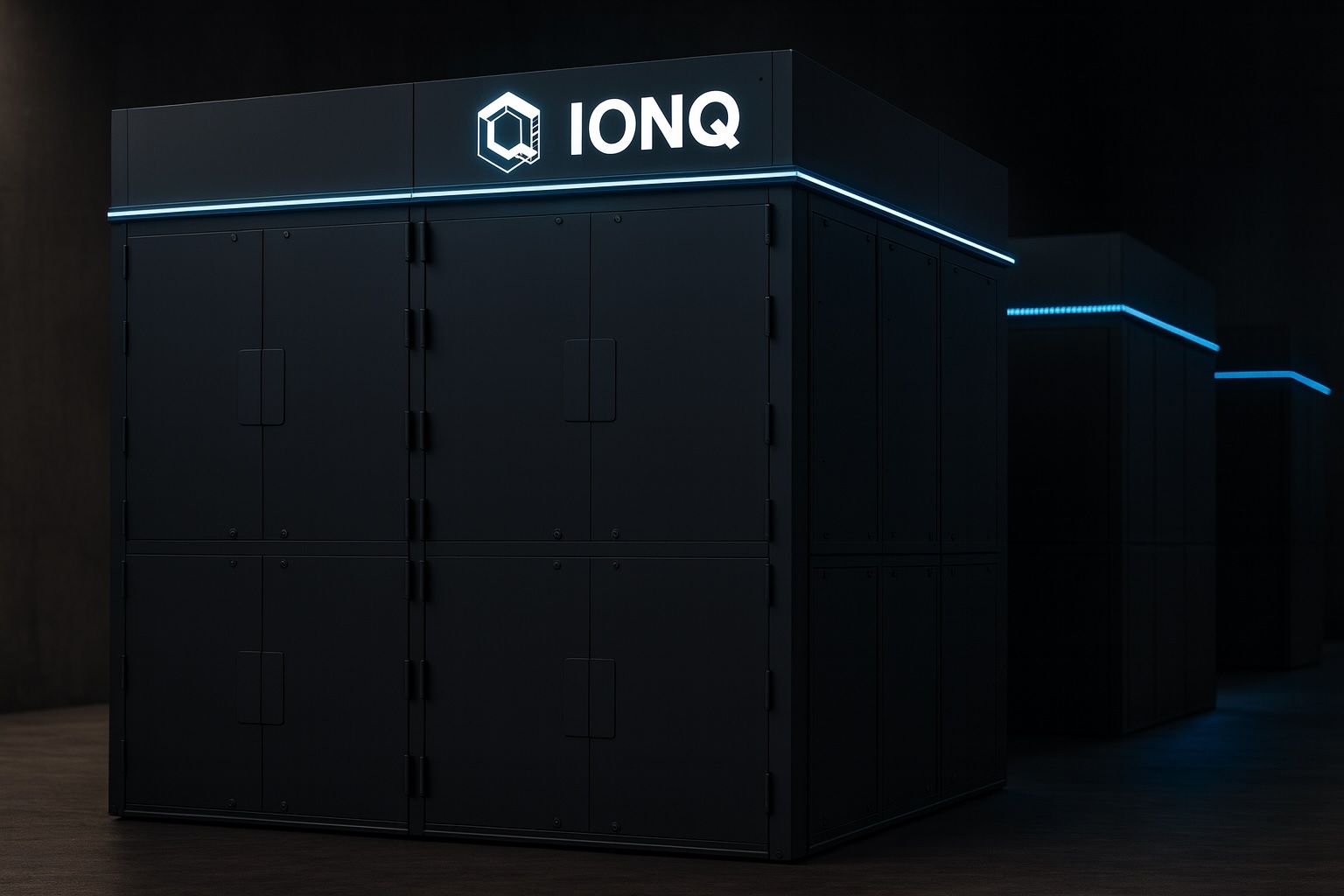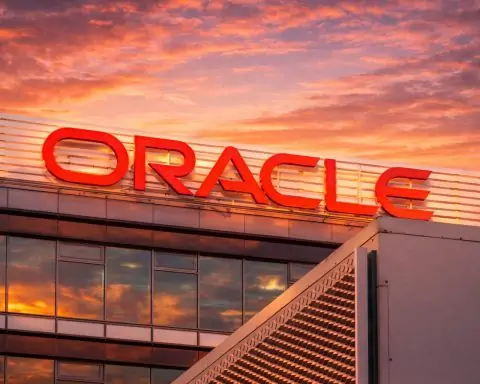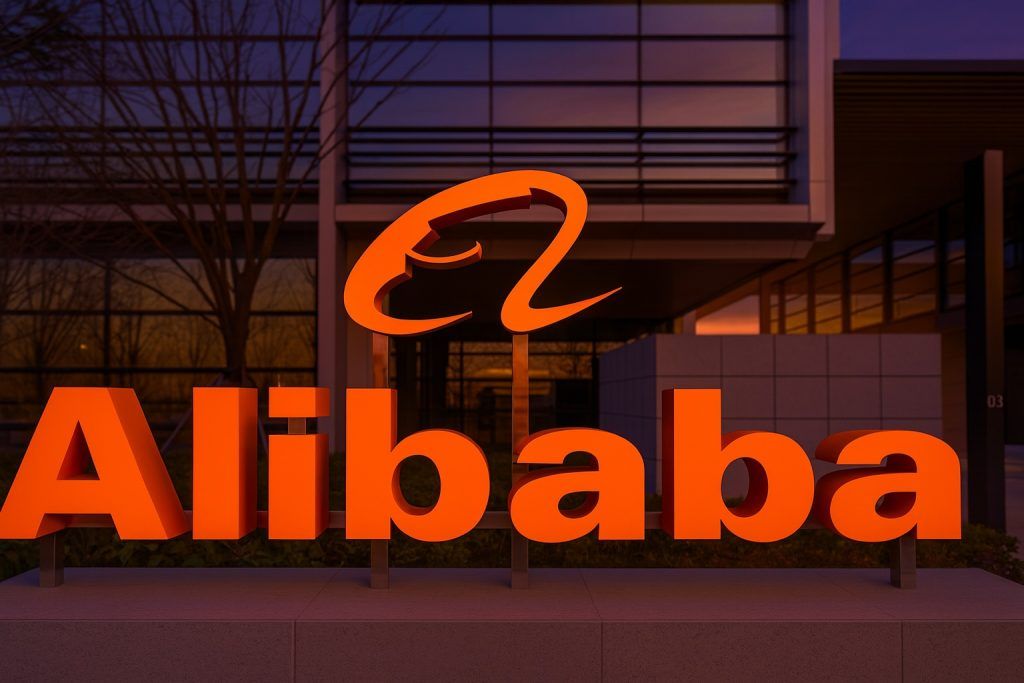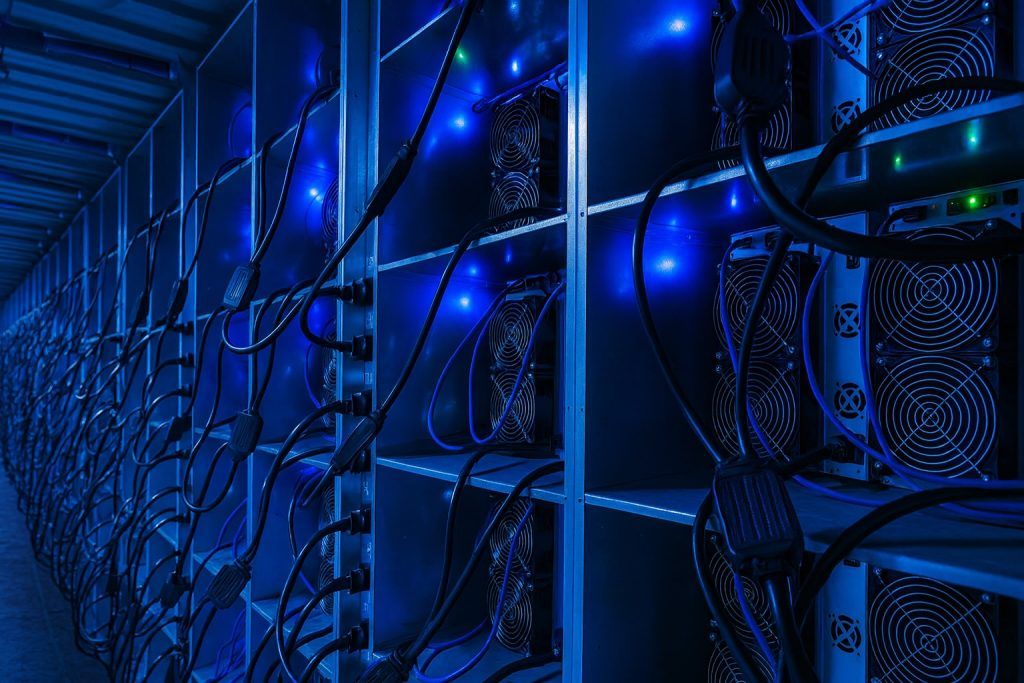- Spectacular Surge & Pullback:IonQ (NYSE: IONQ) shares skyrocketed in 2025 – hitting an all-time high around $82 in early October (up roughly +700% year-over-year) [1]. The stock then reversed about -25% from its peak, settling in the low-$60s by late October [2]. It remains up roughly +75% year-to-date and far above the ~$9 levels of late 2024 [3].
- Quantum Tech Milestone: On October 21, IonQ announced it achieved 99.99% two-qubit gate fidelity, a new world record in quantum computing performance [4]. CEO Niccolò de Masi hailed the breakthrough as a “watershed moment” that brings error-corrected, fault-tolerant quantum systems “years closer” to reality [5]. Earlier in October, IonQ also demonstrated a quantum chemistry simulation beating classical methods for the first time [6], underscoring its technological lead.
- $2 Billion Cash Infusion: IonQ secured an unprecedented $2.0 billion in fresh funding this month via a single institutional investor at a premium price [7]. The mid-October equity offering (16.5 million shares at $93 plus warrants) was one of the largest-ever for a quantum firm [8], giving IonQ a huge war chest (over $3 billion raised in 2025) for R&D and expansion. This cash boost enabled moves like IonQ’s October 7 acquisition of Vector Atomic, a quantum precision sensor startup, in an all-stock deal [9].
- Government Stake Rumors: A Wall Street Journal report on Oct. 22 that the U.S. Commerce Department was mulling equity stakes (~$10 million each) in IonQ and peer quantum firms sparked a sector-wide rally [10]. IonQ’s stock jumped double-digits intraday on the news. However, officials later denied any active negotiations, cooling the euphoria [11]. IonQ still closed that day up ~7% around $59 as investors recalibrated expectations.
- Analysts Divided: Wall Street is split on IonQ. Bullish analysts have hiked 12-month price targets into the $80–$100 range on IonQ’s long-term potential [12], citing its technology leadership and hefty cash reserves. But skeptics warn the stock is vastly overvalued – Morgan Stanley, for example, pegs fair value at just $32 (over -60% below current levels) [13]. The average analyst target sits in the mid-$50s, below the recent price, reflecting caution despite the year’s run-up.
- Sky-High Valuation: IonQ’s market capitalization hovers around $20 billion, which is roughly 200× its expected 2025 revenues [14]. Such a lofty price-to-sales multiple has raised concerns of a hype-driven bubble in quantum computing stocks [15]. While the company’s growth prospects are enormous, critics note its annual sales are still in the tens of millions – highlighting the gap between quantum dreams and present-day fundamentals.
IonQ Stock Soars to Record Highs, Then Pulls Back
IonQ has been on a rollercoaster ride in 2025. The stock started the year under $15 and went on a blistering rally, peaking at $82.59 by October 13 [16]. That price marked an astounding ~700% gain over the prior 12 months, and about +75% since January [17]. It far outpaced the broader market and even most tech stocks. (IonQ’s pure-play quantum peers saw similar explosions – for instance, Rigetti Computing and D-Wave Quantum are up over +2000% year-on-year from penny-stock levels [18].) IonQ’s 52-week range stretched from roughly $9 to $83, reflecting extreme volatility [19] [20]. Double-digit daily swings became almost routine during the frenzy.
However, after notching those record highs, gravity kicked in. Investors began pocketing profits, and IonQ announced a large secondary share offering that introduced some dilution [21]. Within days of its peak, the stock pulled back ~23% into the low-$60s [22]. As of the latest close (Oct. 24), IonQ stands around $60.30 per share [23] – still hundreds of percent above year-ago levels, but well off its apex. The company’s market cap now sits near $20 billion, a valuation many times its current revenue base. One market commentator noted that the recent surge was driven more by “investor optimism, hype, and government support than by fundamentals” [24]. In short, IonQ’s stock has embodied both the euphoria and the whiplash of this year’s quantum boom.
Quantum Breakthroughs Fuel Investor Hype
A key factor behind IonQ’s astronomical rise has been its rapid-fire technical achievements – developments that suggest quantum computing’s potential is moving closer to reality. In mid-October, IonQ announced a headline-grabbing quantum chemistry breakthrough. The company’s latest trapped-ion system managed to simulate atomic-level forces in a complex molecule more accurately than classical supercomputers could [25]. This result, achieved in partnership with a Fortune Global 1000 automotive company, was hailed by CEO Niccolò de Masi as “a clear path for quantum computing to enhance chemical simulations that are foundational to decarbonization technologies.” [26] The news demonstrated practical progress — hinting that IonQ’s machines might tackle real-world problems like materials science and climate solutions. Investors responded with enthusiasm, sending IonQ’s stock up nearly +17% in a single day on October 13 after the announcement [27].
Just a week later, IonQ followed up with another milestone: achieving 99.99% two-qubit gate fidelity in its quantum processors [28]. This four-nines fidelity level is the highest ever recorded for a quantum computing operation. Importantly, IonQ did so using its new Electronic Qubit Control technology, which is designed to be more scalable than traditional laser-based control [29] [30]. “Reaching four-nines fidelity is a watershed moment for IonQ’s quantum leadership,” de Masi said, noting that this accomplishment could shorten the timeline to fault-tolerant, error-corrected quantum computers by years [31]. The improved fidelity means far fewer errors, potentially unlocking a 10^10× performance boost for certain applications, according to the company’s projections [32]. In practical terms, IonQ claims it now has the hardware performance needed to begin scaling toward large-scale systems (it aims for a 256-qubit prototype in 2026 and millions of qubits by 2030).
These advances from IonQ coincide with breakthroughs by tech giants, reinforcing the sense that a quantum revolution is picking up pace. In fact, the same week as IonQ’s fidelity news, Alphabet’s Google announced it developed a landmark quantum algorithm called “Quantum Echoes.” Running on Google’s latest quantum chip, the algorithm performed a complex task 13,000× faster than the best classical supercomputer algorithm could [33]. Google’s team touted this as a step toward “verifiable quantum advantage” – solving real-world problems that classical computing can’t [34] [35]. For investors, such headlines from both a pure-play like IonQ and a heavyweight like Google underscore that quantum computing is rapidly advancing on multiple fronts. This has fed a sense of FOMO in the market – a fear of missing out on what could be the next transformative tech boom, akin to early breakthroughs in personal computers or the internet.
Government Stake Rumors Spur Market Volatility
IonQ’s wild October was not driven by technology news alone. Political winds briefly sent the stock (and its peers) into a frenzy. On October 22, The Wall Street Journal reported that President Trump’s administration was discussing a plan for the U.S. government to take minor equity stakes in certain quantum computing companies – specifically IonQ, Rigetti, and D-Wave – in exchange for increased federal R&D support [36]. The idea of Washington directly investing in these strategic tech firms set off alarm bells and a buying spree. Trading platforms flagged quantum stocks as top gainers that morning, as IonQ jumped roughly 12–15% in pre-market trading on the news [37]. By midday Oct. 22, IonQ’s price had briefly surged from the mid-$50s to over $70 (even touching ~$75 at one point) amid the excitement [38].
However, by that afternoon the euphoria moderated. A Commerce Department official told Reuters that the agency was “not currently negotiating with any of the companies” on such equity stakes [39]. This official denial poured cold water on the speculation and caused quantum stocks to give back a chunk of their gains. IonQ’s spike cooled, and shares settled back to around $59.4 by the close on Oct. 23 – still up ~7% for the day, but well off the session’s highs [40].
The brief saga highlighted just how sensitive IonQ and its cohort are to government and policy news. It also underscored the strategic importance of quantum technology. Observers noted that the mere rumor of U.S. government backing signaled how critical quantum computing is seen for national competitiveness. “Quantum computing offers the chance to really revolutionize the economy, and [this episode shows] the administration doing things in an unconventional way to secure supply chains,” commented one market analyst of the frenzy [41]. Indeed, the Trump administration had recently taken unusual steps like taking equity positions in semiconductor and rare-earth companies as part of a tech supply chain strategy [42]. While no quantum stake deal is confirmed, the incident suggests public-sector interest in ensuring U.S. leadership in quantum – a factor that could translate to future contracts, grants or other support for companies like IonQ. For traders, it was a vivid example of how policy buzz can whipsaw stocks, especially in a nascent industry garnering national security attention.
Cash War Chest and Expansion Moves
Beyond market chatter, IonQ has been aggressively strengthening its financial and strategic position this year, capitalizing on its soaring stock. In October, the company executed a massive capital raise that surprised the market. It announced a $2.0 billion equity offering (priced at $93 per share, about 20% above the prior day’s market price) which was entirely purchased by a single institutional investor, hedge fund Heights Capital Management [43] [44]. This deal, which included additional warrant sweeteners at $155, ranks as one of the largest funding rounds ever by a quantum-focused firm. It instantly boosted IonQ’s cash reserves into the billions – providing a “war chest” to fund research, hiring and acquisitions for years to come. “This is the largest common-stock single-institutional investment in the history of the quantum industry,” CEO Niccolò de Masi proclaimed, adding that the infusion “will facilitate our global growth and accelerate our quantum commercialization worldwide.” [45] [46]
Naturally, issuing 16.5 million new shares does dilute existing shareholders, and IonQ’s stock dipped briefly when the financing was announced [47] [48]. But the premium pricing and the endorsement by a deep-pocketed investor were seen as validation of IonQ’s prospects. The move left IonQ extremely well-capitalized – over $3 billion raised in 2025 alone – removing any near-term funding concerns. It also caught the attention of market pundits. CNBC’s Jim Cramer noted that retail investors would never have absorbed a $2B offering, but an institution doing so “marks the beginning” of serious money backing IonQ, making the stock “very hard to short” going forward [49]. In Cramer’s view, big investors now have skin in the game and may defend the stock if it comes under attack [50]. The substantial cash runway means IonQ can continue investing aggressively in its technology without worrying about running out of capital, a crucial advantage in a race where cutting-edge R&D is expensive and timelines for payoff are uncertain.
IonQ hasn’t hesitated to deploy its capital for strategic expansion. On October 7, the company completed the acquisition of Vector Atomic, a California-based startup specializing in quantum precision timing and sensors [51]. Vector Atomic brings IonQ a team of ~75 experts and technology like advanced atomic clocks and gyroscopes (with purported 1000× GPS accuracy) that can augment IonQ’s capabilities [52] [53]. “The Vector Atomic buy marks an exciting expansion for IonQ as we advance toward fully integrated quantum systems… adding world-class, field-deployed sensing capabilities,” de Masi said in a statement about the deal [54]. In essence, IonQ is branching into quantum sensing – complementing its computing platforms with technologies useful for navigation, timing and defense applications.
This acquisition is part of a broader M&A spree by IonQ to fortify its technology stack. Earlier in 2025, IonQ acquired UK-based Oxford Ionics, known for its high-fidelity ion-trap quantum chip technology, as well as photonics companies LightSmyth (Lightsynq) and Qomplx (Capella Space) [55]. Those purchases added photonic interconnect and quantum networking know-how – crucial pieces for building scalable, distributed quantum computing systems. Thanks to these moves, IonQ now touts an end-to-end quantum portfolio spanning computing, networking, and sensing. It’s an approach aimed at positioning the firm as a one-stop platform for quantum solutions, which could pay off in both technological synergies and future revenue streams (e.g. quantum communications, navigation systems, etc.).
IonQ is also forging high-profile partnerships and customer collaborations to cement its leadership. It has signed memoranda of understanding with major research institutes in South Korea (KISTI) and Japan (AIST) to co-develop quantum applications [56]. The company even made a strategic investment in autonomous vehicle startup Einride to explore using quantum optimization for logistics and routing problems [57]. Perhaps most significantly, Amazon.com – a key cloud partner – disclosed it had taken a $36.7 million equity stake in IonQ earlier this year [58]. Amazon’s involvement (likely through its AWS unit, which offers IonQ’s machines via the cloud) is seen as a strong vote of confidence in IonQ’s technology from a tech giant. IonQ counts other blue-chip partners and clients as well: Microsoft’s Azure Quantum, Google Cloud, NVIDIA, and pharma heavyweight AstraZeneca are among those experimenting with IonQ’s systems for real-world use cases [59]. These alliances not only lend credibility, but also help IonQ drive early revenue via cloud access fees and joint research projects. In recognition of its growth, IonQ was the only quantum pure-play included in Fortune’s 2025 “Future 50” list of companies with big long-term upside [60]. All told, IonQ’s flurry of activity – from raising capital and making acquisitions to partnering with industry leaders – has kept a steady drumbeat of positive news behind the stock, fueling investor enthusiasm even as skeptics urge caution.
Analyst Targets and Market Outlook
With IonQ’s share price on a tear, opinions on Wall Street are sharply divided about what comes next. Some analysts see IonQ as the pioneer to bet on in the quantum race, while others warn that expectations (and the stock’s valuation) have raced far ahead of reality.
On the bullish side, several brokerage firms have issued aggressive price targets amid IonQ’s 2025 surge. B. Riley Financial, for example, bumped its target up to $100 (from an already high $75) after recent developments [61]. Needham & Co. likewise raised its 12-month target to $80 [62]. A host of analysts at smaller firms have Buy ratings with targets in the $60–$75 range [63], suggesting further upside from the current ~$60 price. Proponents argue that IonQ’s technology lead and bold roadmap justify these valuations. They point to IonQ’s record-setting hardware performance (e.g. achieving a best-in-class #AQ 64 benchmark, reportedly outpacing even IBM’s quantum systems) and its plan to scale to 2 million qubits by 2030 [64]. The company’s early traction with marquee clients – including cloud giants and Fortune 500 companies – is seen as validation of its commercial potential [65]. Crucially, IonQ’s fortified balance sheet (over $3B cash) gives it the staying power to invest and possibly emerge as the long-term winner in quantum computing [66]. Bulls often cite the enormous addressable market: Boston Consulting Group projects $500+ billion by 2040 for quantum tech, and some estimates run into the trillions beyond that [67]. From this perspective, IonQ’s ~$20B market cap could ultimately be justified if the company retains its leadership in an industry that revolutionizes everything from pharmaceuticals to finance. In short, the optimistic camp believes IonQ is the real deal – a rare pure-play leader in a transformative technology – and that today’s valuation will look small in hindsight if quantum computing achieves its promise.
In the bearish camp, however, are those who feel IonQ’s stock has become unmoored from fundamentals. Despite recent revenue growth, the company is still expected to post only about $45–50 million in revenue for the full year 2024, and perhaps ~$80–100 million in 2025 (IonQ recently raised its 2025 revenue guidance to that range) [68]. Earning tens of millions while being valued in the tens of billions translates to extraordinarily rich multiples. By one calculation, IonQ’s forward price-to-sales ratio exceeds 200× – compared to single-digit multiples for most tech stocks [69] [70]. “Eye-popping” valuations like this, critics say, imply that investors are pricing in years (if not decades) of growth and technical progress that still lie ahead [71] [72]. Wall Street giant Morgan Stanley has been one of the more vocal skeptics: in September it reiterated an Underweight rating on IONQ with a mere $32 price target [73]. That forecast suggests the stock could fall more than 60% from current levels. The Morgan Stanley analysts acknowledge IonQ’s technical accomplishments but essentially argue the stock is in a bubble, given a ~$20B valuation against negligible current revenues [74]. Another research outfit, Weiss Ratings, recently slapped a “Sell (D-)” grade on IonQ, citing the company’s ongoing losses and the fact that “quantum computing is still in its infancy” with uncertain payoff timelines [75]. Even some long-term quantum bulls urge caution now: the Nasdaq-affiliated Motley Fool warned that history shows early tech hype often overshoots reality, reminding investors that breakthroughs like the internet took years longer to mature (with many stumbles along the way) than the market’s initial euphoria expected [76]. The consensus of more than half a dozen analysts covering IonQ lands around the high-$50s per share [77] – below where the stock traded for much of October. In other words, even many who believe in IonQ’s prospects see the current price as fully valued or requiring flawless execution to grow into.
This stark divergence in views – with targets ranging from ~$30 on the low end to ~$100 on the high end – highlights the uncertainty surrounding IonQ’s future. Notably, short sellers who bet against the stock have been forced to tread carefully. IonQ’s huge cash raise means it won’t run out of money anytime soon (a common thesis for shorting unprofitable startups). As Jim Cramer observed, the infusion from Heights Capital effectively extended IonQ’s runway and brought in big institutional support, making it a tougher target for skeptics [78]. “Retail can’t handle a $2 billion offering… the fact they can sell this much to an institution marks the beginning” of serious backing, Cramer said, suggesting IonQ “may now be emerging as the one to watch.” [79] Still, the road ahead is sure to be volatile. All sides agree that quantum computing remains in early development – practical, large-scale use could be years away, and competition from giants like IBM, Google, and others is intensifying. Any technological setbacks or slower-than-expected progress in coming quarters could deal a reality check to lofty valuations [80].
Looking forward, investors won’t have to wait long for more signals. IonQ is scheduled to report Q3 2025 earnings on November 5, which will update its revenue traction and R&D spending [81]. In its last report, IonQ’s sales were growing ~80% year-over-year (albeit off a small base) and it raised full-year guidance to ~$90M [82] [83]. If the company can continue that momentum or announce new big contracts, it may bolster the bulls’ case that real commercial growth is underway. On the other hand, any hint of slowing growth or outsized losses could prompt some investors to hit the brakes, given the stock’s high expectations. Beyond earnings, the news flow will likely keep dictating IonQ’s moves – whether it’s a new quantum performance record, a major cloud partnership, government policy updates, or competitor breakthroughs. As one market outlook noted, “quantum hardware stocks will continue to react sharply to technological announcements, funding rounds, and early commercialization successes or failures.” [84] In the near term, that means IonQ’s share price could spike higher on any positive breakthrough or big contract – but could just as easily tumble on an earnings miss or broader market jitters [85].
Bottom Line: IonQ has become the poster child of the 2025 quantum investing frenzy, embodying both the enormous promise and the substantial risk of this frontier sector. The company’s achievements – from record-breaking qubit fidelity to real-world quantum simulations – and its hefty backing of capital have given believers plenty to be excited about. At the same time, its $20B valuation and triple-digit stock swings reflect a market priced for perfection in a field still navigating scientific hurdles. As IonQ enters the final stretch of 2025, all eyes are on whether it can continue delivering tangible progress to justify the hype. For public investors and enthusiasts alike, the next few months will be critical in determining if IonQ’s quantum leap is on a sustainable trajectory, or if this rocket ship needs to return closer to earth. In the words of one analyst, the market is currently “pricing in years of growth and technical progress that must still be realized” [86] [87] – a reminder that the quantum gold rush of 2025 could still face many twists and turns before the technology truly comes of age.
Sources: TechStock² (TS2.tech) analysis [88] [89] [90] [91]; Yahoo Finance / Nasdaq reports [92] [93]; Reuters [94] [95]; Market data from StockAnalysis [96]; and company press releases and earnings statements as cited.
References
1. ts2.tech, 2. ts2.tech, 3. ts2.tech, 4. ts2.tech, 5. ts2.tech, 6. ts2.tech, 7. ts2.tech, 8. ts2.tech, 9. ts2.tech, 10. ts2.tech, 11. ts2.tech, 12. ts2.tech, 13. ts2.tech, 14. ts2.tech, 15. ts2.tech, 16. ts2.tech, 17. ts2.tech, 18. ts2.tech, 19. ts2.tech, 20. ts2.tech, 21. ts2.tech, 22. ts2.tech, 23. stockanalysis.com, 24. ts2.tech, 25. ts2.tech, 26. ts2.tech, 27. ts2.tech, 28. ts2.tech, 29. thequantuminsider.com, 30. thequantuminsider.com, 31. ts2.tech, 32. ts2.tech, 33. www.reuters.com, 34. www.scientificamerican.com, 35. www.reuters.com, 36. ts2.tech, 37. ts2.tech, 38. ts2.tech, 39. ts2.tech, 40. ts2.tech, 41. ts2.tech, 42. ts2.tech, 43. ts2.tech, 44. ts2.tech, 45. ts2.tech, 46. ts2.tech, 47. ts2.tech, 48. ts2.tech, 49. ts2.tech, 50. ts2.tech, 51. ts2.tech, 52. ts2.tech, 53. ts2.tech, 54. ts2.tech, 55. ts2.tech, 56. ts2.tech, 57. ts2.tech, 58. ts2.tech, 59. ts2.tech, 60. ts2.tech, 61. ts2.tech, 62. ts2.tech, 63. ts2.tech, 64. ts2.tech, 65. ts2.tech, 66. ts2.tech, 67. ts2.tech, 68. ts2.tech, 69. ts2.tech, 70. ts2.tech, 71. ts2.tech, 72. ts2.tech, 73. ts2.tech, 74. ts2.tech, 75. ts2.tech, 76. ts2.tech, 77. ts2.tech, 78. ts2.tech, 79. ts2.tech, 80. ts2.tech, 81. ts2.tech, 82. ts2.tech, 83. ts2.tech, 84. ts2.tech, 85. ts2.tech, 86. ts2.tech, 87. ts2.tech, 88. ts2.tech, 89. ts2.tech, 90. ts2.tech, 91. ts2.tech, 92. ts2.tech, 93. ts2.tech, 94. www.reuters.com, 95. ts2.tech, 96. stockanalysis.com







